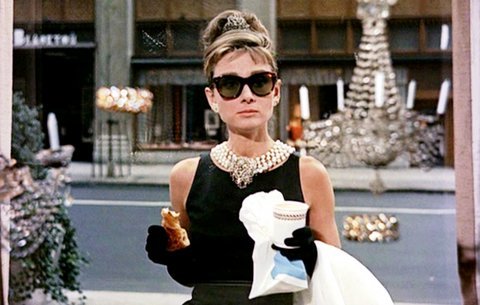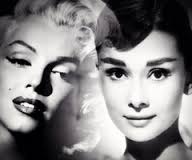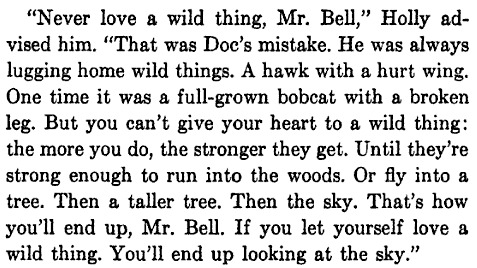What do you think?
Rate this book


142 pages, Paperback
First published January 1, 1958



Her bedroom was consistent with her parlor: it perpetuated the same camping-out atmosphere; crates and suitcases, everything packed and ready to go, like the belongings of a criminal who feels the law not far behind.
“You’re wrong. She is a phony. But on the other hand you’re right. She isn’t a phony because she’s a real phony. She believes all this crap she believes. You can’t talk her out of it. I’ve tried with tears running down my cheeks.”
I don’t mean I’d mind being rich and famous. That’s very much on my schedule, and someday I’ll try to get around to it; but if it happens, I’d like to have my ego tagging along. I want to still be me when I wake up one fine morning and have breakfast at Tiffany’s.




"it's better to look at the sky than live there; such an empty place, so vague, just a country where the thunder goes and things disappear."
"Anyway, home is where you feel at home. I'm still looking."
"You've got to be sensitive to appreciate her: a streak of the poet. But I'll tell you the truth. You can beat your brains out for her, and she'll hand you horseshit on a platter."
"Never love a wild thing, Mr. Bell,"
"Don't wanna sleep, don't wanna die, just wanna go a-travelin' through the pastures of the sky."
"and believe me, dearest Doc -- it's better to look at the sky than live there. Such an empty place; so vague. Just a country where the thunder goes and things disappear."

“Paramount double-crossed me in every way and cast Audrey.”

Playboy: "Would you elaborate on your comment that Holly was the prototype of today's liberated female and representative of a "whole breed of girls who live off men but are not prostitutes. They're our version of the geisha girl."?Breakfast at Tiffany's excels in imagery, the prose lyrical. It has many layers to it. Abandonment, loneliness, the need to belong and yet not be chained at the same time, the delight in the unorthodox and not loving a wild thing.
Capote: "Holly Golightly was not precisely a callgirl. She had no job, but accompanied expense-account men to the best restaurants and night clubs, with the understanding that her escort was obligated to give her some sort of gift, perhaps jewelry or a check ... if she felt like it, she might take her escort home for the night. So these girls are the authentic American geishas, and they're much more prevalent now than in 1943 or 1944, which was Holly's era.."?

Holly:"... good things only happen to you if you're good. Good? Honest is more what I mean. Not law-type honest -- I'd rob a grave, I'd steal two-bits off a dead man's eyes if I thought it would contribute to the day's enjoyment -- but unto-thyself-type honest. Be anything but a coward, a pretender, an emotional crook, a whore: I'd rather have cancer than a dishonest heart. Which isn't being pious. Just practical. Cancer may cool you, but the other's sure to. Oh, screw it, cookie -- hand me my guitar, and I'll sing you a fada in the most perfect Portuguese."Her story is narrated by her upstairs neighbor, an aspiring writer, who befriended her, despite a downstairs neighbor, Madame Sapphia Spanella's outspoken wrath against Holly: "A crude exhibitionist, a time waster, an utter fake, somebody never to be spoken to again". But Holly was also 'pampered, calmly immaculate, as though she'd been attended by Cleopatra's maids'.
"Fred's a soldier," said Holly. "But I doubt if he'll ever be a statue. Could be. They say the more stupid you are the braver. He's pretty stupid."This is a short novella, about a female character who deserved her place as one of the most outstanding literary characters of all times. What captured me the most is the way this young woman was presented to the world. Someone who could be loved; a young woman who could become a friend. She had heart and soul. She was warm and wonderful. But just as cold and calculating, since she did not quite trust the people's intentions towards her and therefore never really allowed herself to bond with anyone.
"Fred's that boy upstairs? I didn't realize he was a soldier. But he does look stupid."
"Yearning. Not stupid. He wants awfully to be on the inside staring out: anybody with their nose pressed against a glass is liable to look stupid. Anyhow, he's a different Fred. Fred's my brother."
"You call your own f-f-flesh and b-b-blood stupid?"
"If he is he is."
"I like a man who sees the humor; most of them, they're all pant and puff."Her actions prevented people to come too near, even her friends stood aside. A tragic figure. A statistic for the cognoscenti, the people who despised the likes of her.